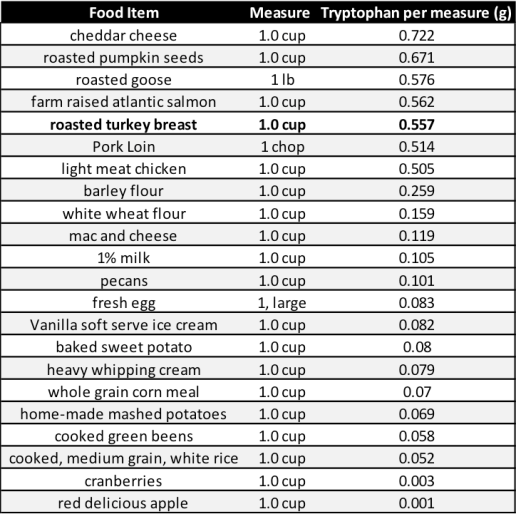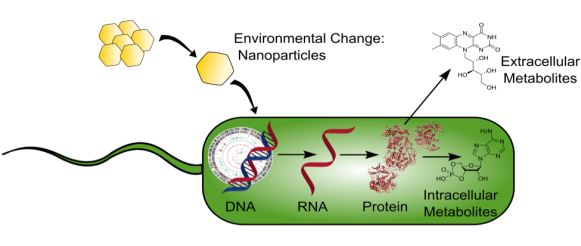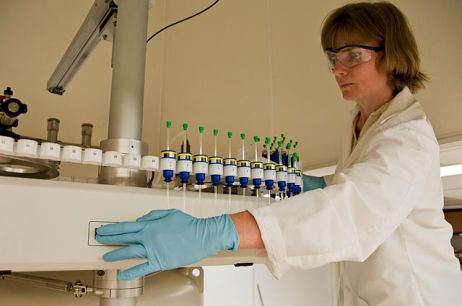Every Thanksgiving we gorge ourselves on delicious food and become very sleepy. Inevitably at that point, someone volunteers that it’s the turkey that’s made you tired. Turkey meat contains a naturally occurring amino acid called L-tryptophan, which is necessary for the synthesis of melatonin, which in turn helps regulate sleep cycles.1 It has been shown that consumption of over 1 gram of L-tryptophan increases sleepiness and decreases the amount of time it takes to fall asleep,2 so it’s not a big leap to assume that eating L-tryptophan in turkey would make us sleepy.

However, according to the United States Department of Agriculture (USDA) Food Composition Databases, a number of other foods also contain tryptophan, and some even more than turkey. Meats such as salmon, chicken, and pork are comparable to turkey in levels of L-tryptophan, but foods like cheddar cheese actually have significantly more! These other everyday foods (see the table below) are not known for making people tired, so this suggests that it is not fair to blame the turkey for making us sleepy on Thanksgiving. Instead, the most likely culprit is simply excess food in general. Digestion can take a lot of energy, and (especially if you add in any alcohol!) it can make you feel slow and groggy.

Despite being untrue, sleepiness due to turkey consumption remains one of the most popular food myths.3 If you’re interested in learning more about tryptophan and turkey, you can read about it on WebMD.4
Besides tryptophan, there are other molecules in food that are known to have specific effects on humans. For example, propanethiol S-oxide makes you cry when cutting an onion.5 Additionally, numerous foods contain caffeine, which wakes us up. Even the antibiotic penicillin is produced naturally by a mold, which facilitated its discovery. These are examples of naturally produced molecules from living organisms that scientists call natural products. A subset of natural products are produced by the metabolism of an organism — the process by which chemical transformations occur to convert fuel to energy, make cellular building blocks, or get rid of waste. This group of natural products are referred to as metabolites.

Believe it or not, this leads us to some science that is relevant to the Center for Sustainable Nanotechnology. Changes in metabolism can be used as an indicator of an organism’s health; therefore, the study of natural products and metabolites is a useful tool for studying toxicity (for more on toxicity and toxicology, check out our old blog posts here and here). Organisms can sense fluctuations in their environment, which leads to changes in the amounts of certain metabolites. For example, nanoparticles can change the natural environment of the organism, and the organism will have to respond in an attempt to maintain chemical balance. It is possible to understand the toxicity of nanoparticles by looking at how many bacteria die upon exposure (see this blog post), but scientists can also interpret how organisms respond to these changes by tracking the fluctuations in their metabolites. By knowing which molecules an organism produces (i.e. the byproducts of all the cellular processes happening within the cell) we can actually understand how nanoparticles may be toxic and how organisms adapt to environmental change.
The process of studying all the metabolites that an organism makes is called metabolomics. The -omics suffix means global or collective, so metabolomics literally translates to the study of “the whole collection of metabolites” (you might have heard the term genomics, meaning the study of “the whole collection of genes” in an organism). There are two major methods for doing metabolomics studies: 1) mass spectrometry and 2) Nuclear Magnetic Resonance (NMR) Spectroscopy. In mass spectrometry, samples are charged and the metabolites are measured by comparing their mass to their charge, which can help identify what they are. NMR works by seeing how atoms in a metabolite are affected by a magnetic field. This can tell you what elements are in the metabolite and how they are connected, which also helps with identification of the metabolite.

All living organisms, including your Thanksgiving turkey, have metabolic pathways that scientists can track to understand their importance. For example, tryptophan is an amino acid that is one of 20 building blocks that make proteins. In humans, the tryptophan we eat can be converted into serotonin (to regulate your mood) and melatonin (to regulate your circadian rhythm). We can even track the conversion of metabolites in people. If we were really interested in putting the “turkey makes you sleepy” myth to rest, we could compare the levels of melatonin people produce after eating foods that have a variety of concentrations of tryptophan. I’m not aware of any researchers who have actually done that study, but I’m sure it’s only a matter of time.
 Happy Thanksgiving!
Happy Thanksgiving!
EDUCATIONAL RESOURCES
- ACS Reactions video: What happens when we eat too much?
- University of Utah Health Sciences: Metabolism: From Food to Fuel
REFERENCES
- Slominski, A. et al. Conversion of L-tryptophan to serotonin and melatonin in human melanoma cells. FEBS Letters. 2002, 551, 102-106. doi: 10.1016/S0014-5793(01)03319-1
- Harmann, E. Effects of L-tryptophan on sleepiness and on sleep. Journal of Psychiatric Research. 1982, 17, 107-113. doi: 10.1016/0022-3956(82)90012-7
- Jones, P. et al. Accuracy of comparing bone quality to chocolate bars for patient information purposes: observational study. BMJ. 2007, 335 (7633), 1285-7. doi: 10.1136/bmj.39413.798472.BE
- Zamosky, L. The Truth About Tryptophan. WebMD. 2009, retrieved from http://www.webmd.com/food-recipes/features/the-truth-about-tryptophan#3
- Block, E.et al. Allium Chemistry: Microwave Spectroscopic Identification, Mechanism of Formation, Synthesis, and Reactions of (E,Z)-Propanethial S-Oxide, the Lachrymatory Factor of the Onion (Allium cepa). Journal of the American Chemical Society. 1996, 118 (32), 7492-7501. doi: 10.1021/ja960722j

Thank you for this informative and timely article!
That’s a marvelously clear and entertaining article! Now I understand a bit more about amino acids and metabolomoics – and what “-omics” in general means!